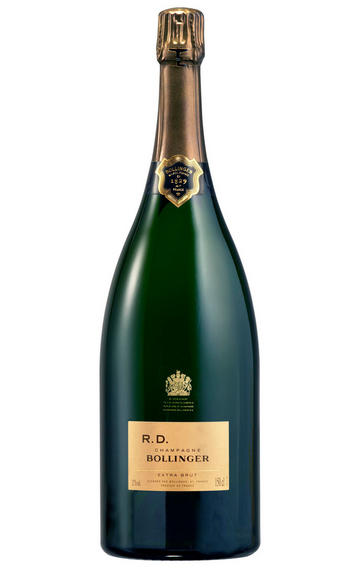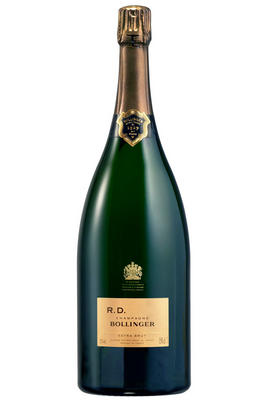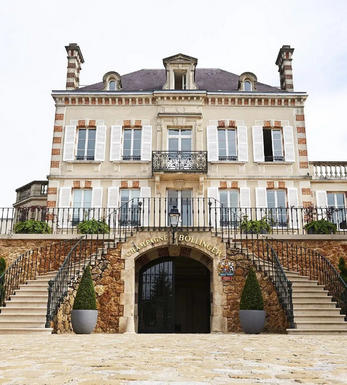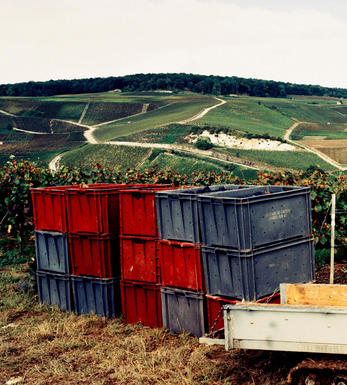
2004 Champagne Bollinger, R.D., Extra Brut

About this WINE

Bollinger
The Champagne House of Bollinger was established in 1829 by Jacques Bollinger and Paul Renaudin. Over the years the vineyard holdings have been steadily increased with the largest expansion taking place under the stewardship of the legendary Mme Lily Bollinger. She ran the company between 1941 and 1977 and today it is managed by her great-nephew, Ghislain de Montgolfier.
Bollinger has a reputation for producing muscular champagnes with body, depth and power, and is today considered one of the "Great" Champagne houses.
70% of the grapes come from the firm's own vineyards. 80% of the harvest is barrel-fermented with the wines being kept on their yeast lees for an extended period of time (in the case of the RD, around 10 years).
Bollinger produces classic, complex, Pinot-Noir dominated champagnes with the ability to age gracefully for many years.

Recently Disgorged
The Recently Disgorged (RD) Champagne style was introduced for the first time by Madame Bollinger in 1961, on the 1952 Bollinger La Grande Année vintage. Disgorgement (or dégorgement) is a core process in the traditional method of sparkling wine-making. It involves the removal of the frozen sediment (yeast) collected in a plastic pot (pellet) at the neck of the inverted bottle, at the conclusion of the Champagne's ageing process after the second fermentation.
In instances where disgorgement is deliberately delayed to the point just prior to the release of the bottling to the market, the Champagne benefits from a prolonged maturation on its lees (yeast), which reinforces the aromatic subtlety and complexity of the final wine. Most importantly, late disgorgement allows the Champagne to retain its freshness, vivacity and fruity expression despite the ageing.
Recommended Producers: Bollinger RD the most famous and exquisite exponent of the style, Pol Roger.

Champagne blend
Which grapes are included in the blend, and their proportion, is one of the key factors determining the style of most Champagnes. Three grapes are used - Pinot Noir, Chardonnay and Pinot Meunier.
26% of vineyards in Champagne are planted with Chardonnay and it performs best on the Côtes des Blancs and on the chalk slopes south of Epernay. It is relatively simple to grow, although it buds early and thus is susceptible to spring frosts. It produces lighter, fresher wines than those from Burgundy and gives finesse, fruit and elegance to the final blend. It is the sole grape in Blancs de Blancs, which are some of the richest long-lived Champagnes produced.
Pinot Noir accounts for nearly 40% of the plantings in Champagne and lies at the heart of most blends - it gives Champagne its body, structure, strength and grip. It is planted across Champagne and particularly so in the southern Aube district.
The final component is Pinot Meunier and this constitutes nearly 35% of the plantings. Its durability and resistance to spring frosts make the Marne Valley, a notorious frost pocket, its natural home. It ripens well in poor years and produces a soft, fruity style of wine that is ideal for blending with the more assertive flavours of Pinot Noir. Producers allege that Pinot Meunier lacks ageing potential, but this does not deter Krug from including around 15% of it in their final blends.


Buying options
Add to wishlist
Description
The very concept of Bollinger’s R.D. is inspired in part by the old Champenoise custom of especially disgorging a bottle from the cellar to mark a special occasion. Call me an old romantic but that seems to me a tradition that is well worth continuing, especially with the 26th R.D. – the alluring 2004. Its full on Bolly on the nose; broad opulent and fleshy. A sunny, generous character underlines the fruit which range from mirabelle plum, to citrus zest to a touch of redcurrant from the 66% pinot noir. Now here comes the magic; nougat, roasted hazelnuts, flaky pastry all manner of doughy, bready deliciousness that only comes from some 12 years developing sur lie. It’s rich but finely balanced with fantastic concentration on the palate, a Champagne to treat like fine Burgundy now and over the next decade.
Jared Ehret, Private Account Manager
wine at a glance
Delivery and quality guarantee